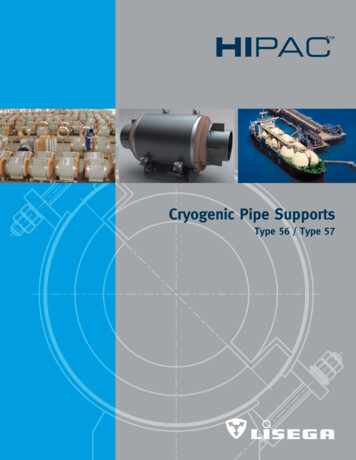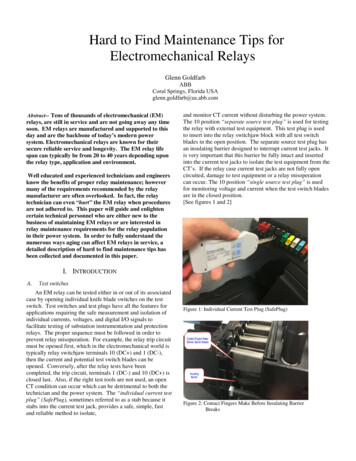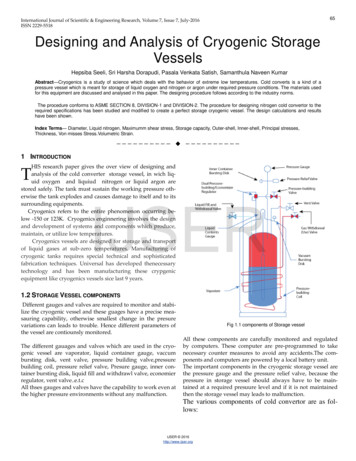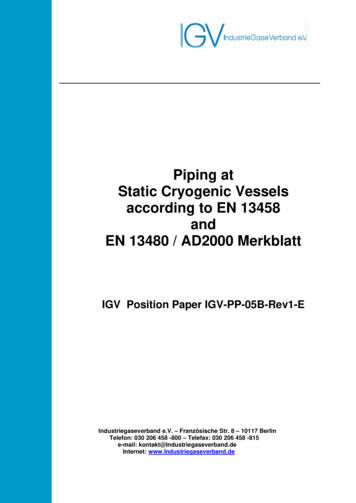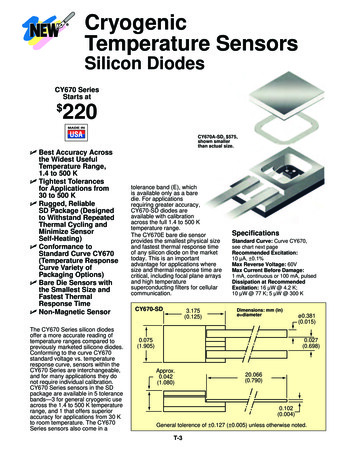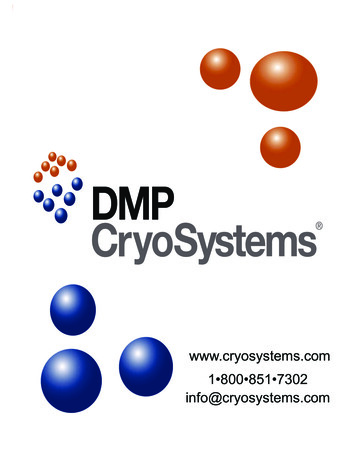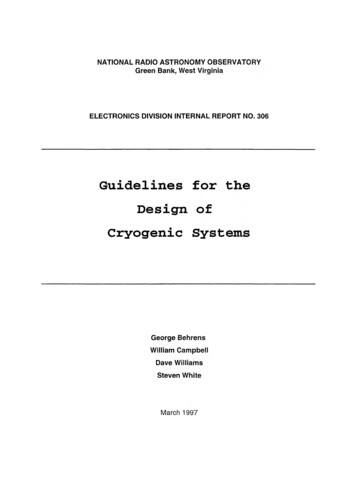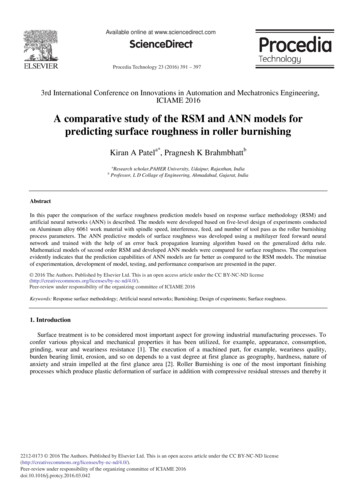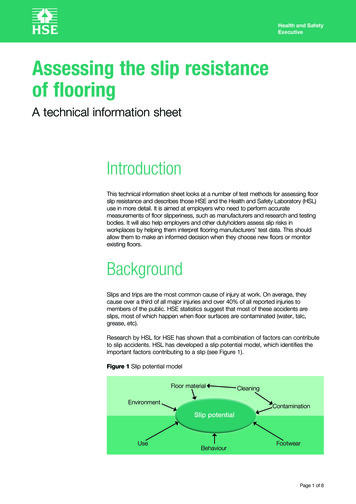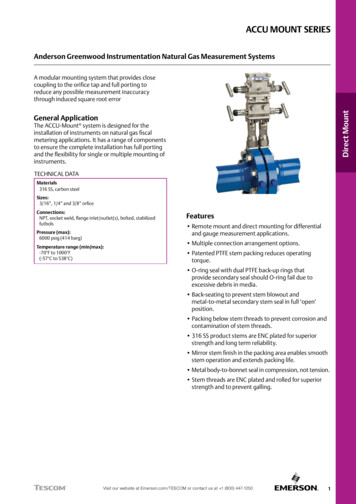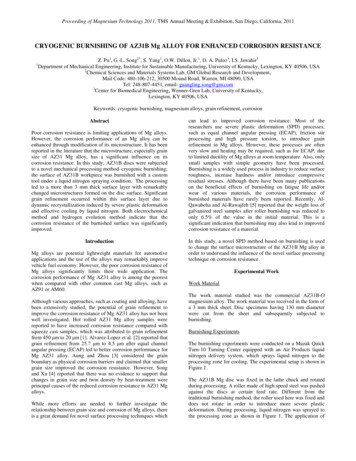
Transcription
Proceeding of Magnesium Technology 2011, TMS Annual Meeting & Exhibition, San Diego, California, 2011CRYOGENIC BURNISHING OF AZ31B Mg ALLOY FOR ENHANCED CORROSION RESISTANCEZ. Pu1, G.-L. Song2*, S. Yang1, O.W. Dillon, Jr.1, D. A. Puleo3, I.S. Jawahir1Department of Mechanical Engineering, Institute for Sustainable Manufacturing, University of Kentucky, Lexington, KY 40506, USA2Chemical Sciences and Materials Systems Lab, GM Global Research and Development,Mail Code: 480-106-212, 30500 Mound Road, Warren, MI 48090, USATel: 248-807-4451, email: guangling.song@gm.com3Center for Biomedical Engineering, Wenner-Gren Lab, University of Kentucky,Lexington, KY 40506, USA1Keywords: cryogenic burnishing, magnesium alloys, grain refinement, corrosionAbstractPoor corrosion resistance is limiting applications of Mg alloys.However, the corrosion performance of an Mg alloy can beenhanced through modification of its microstructure. It has beenreported in the literature that the microstructure, especially grainsize of AZ31 Mg alloy, has a significant influence on itscorrosion resistance. In this study, AZ31B discs were subjectedto a novel mechanical processing method–cryogenic burnishing;the surface of AZ31B workpiece was burnished with a customtool under a liquid nitrogen spraying condition. The processingled to a more than 3 mm thick surface layer with remarkablychanged microstructures formed on the disc surface. Significantgrain refinement occurred within this surface layer due todynamic recrystallization induced by severe plastic deformationand effective cooling by liquid nitrogen. Both electrochemicalmethod and hydrogen evolution method indicate that thecorrosion resistance of the burnished surface was significantlyimproved.IntroductionMg alloys are potential lightweight materials for automotiveapplications and the use of the alloys may remarkably improvevehicle fuel economy. However, the poor corrosion resistance ofMg alloys significantly limits their wide application. Thecorrosion performance of Mg AZ31 alloy is among the poorestwhen compared with other common cast Mg alloys, such asAZ91 or AM60.Although various approaches, such as coating and alloying, havebeen extensively studied, the potential of grain refinement toimprove the corrosion resistance of Mg AZ31 alloy has not beenwell investigated. Hot rolled AZ31 Mg alloy samples werereported to have increased corrosion resistance compared withsqueeze cast samples, which was attributed to grain refinementfrom 450 μm to 20 μm [1]. Alvarez-Lopez et al. [2] reported thatgrain refinement from 25.7 μm to 4.5 μm after equal channelangular pressing (ECAP) led to better corrosion performance forMg AZ31 alloy. Aung and Zhou [3] considered the grainboundary as physical corrosion barriers and claimed that smallergrain size improved the corrosion resistance. However, Songand Xu [4] reported that there was no evidence to support thatchanges in grain size and twin density by heat-treatment wereprincipal causes of the reduced corrosion resistance in AZ31 Mgalloys.While more efforts are needed to further investigate therelationship between grain size and corrosion of Mg alloys, thereis a great demand for novel surface processing techniques whichcan lead to improved corrosion resistance. Most of theresearchers use severe plastic deformation (SPD) processes,such as equal channel angular pressing (ECAP), friction stirprocessing and high pressure torsion, to introduce grainrefinement in Mg alloys. However, these processes are oftenvery slow and heating may be required, such as for ECAP, dueto limited ductility of Mg alloys at room temperature. Also, onlysmall samples with simple geometry have been processed.Burnishing is a widely used process in industry to reduce surfaceroughness, increase hardness and/or introduce compressiveresidual stresses. Although there have been many publicationson the beneficial effects of burnishing on fatigue life and/orwear of various materials, the corrosion performance ofburnished materials have rarely been reported. Recently, AlQawabeha and Al-Rawajfeh [5] reported that the weight loss ofgalvanized steel samples after roller burnishing was reduced toonly 6.5% of the value in the initial material. This is asignificant indication that burnishing may also lead to improvedcorrosion resistance of a material.In this study, a novel SPD method based on burnishing is usedto change the surface microstructure of the AZ31B Mg alloy inorder to understand the influence of the novel surface processingtechnique on corrosion resistance.Experimental WorkWork MaterialThe work material studied was the commercial AZ31B-Omagnesium alloy. The work material was received in the form ofa 3 mm thick sheet. Disc specimens having 130 mm diameterwere cut from the sheet and subsequently subjected toburnishing.Burnishing ExperimentsThe burnishing experiments were conducted on a Mazak QuickTurn-10 Turning Center equipped with an Air Products liquidnitrogen delivery system, which sprays liquid nitrogen to theprocessing zone for cooling. The experimental setup is shown inFigure 1.The AZ31B Mg disc was fixed in the lathe chuck and rotatedduring processing. A roller made of high speed steel was pushedagainst the discs at certain feed rate. Different from thetraditional burnishing method, the roller used here was fixed anddoes not rotate in order to introduce more severe plasticdeformation. During processing, liquid nitrogen was sprayed tothe processing zone as shown in Figure 1. The application of
Proceeding of Magnesium Technology 2011, TMS Annual Meeting & Exhibition, San Diego, California, 2011liquid nitrogen was to remarkably reduce the temperature duringprocessing and suppress the growth of ultrafine/nano grainsintroduced by dynamic recrystallization (DRX).The burnishing speed refers to the linear speed at the contactpoint between the fixed roller and the disc. It was 100 m/min.The feed rate was 0.01 mm/rev. The process was stopped whenthe final diameter reduced to 125 mm.Nozzleforliquid nitrogendeliveryFixedrollerElectrochemical MeasurementA Solatron 1280 potentiostat system was used for polarizationcurve and AC impedance measurements. Only the processedsurface was exposed to the testing solution and all the othersurfaces are protected by a thick layer of MICCROSTOPlacquer. The exposed area was 1.5 cm2. The testing solution was5 wt. % NaCl. A platinum gauze was used as a counter electrodeand a KCl-saturated Ag/AgCl electrode was used as a referencein the cell. During AC impedance measurements, the frequencyranged from 17,777 Hz to 0.1 Hz with 7 points/decade, and theamplitude of the sinusoidal potential signal was 5mV withrespect to the OCP. Potentiodynamic polarization curvemeasurements were performed at a potential scanning rate of 0.1mV/s from 0.3 V vs. OCP to 1.0 V vs. reference.AZ31Mg discHydrogen Evolution MeasurementLiquidnitrogenIn addition to electrochemical methods, hydrogen evolutionmethod [6] was also used to compare the corrosion rates ofsamples after cryogenic burnishing and after grinding. Thesamples were mounted in epoxy resin and only the processedsurface was exposed to 5 wt. % NaCl. The exposed area was 1.5cm2. Pipettes with 0.1 mL interval were used to collect theevolved hydrogen from the samples.BurnishingSpeedFeed RateResults and DiscussionMicrostructureGrinding TreatmentTo eliminate the possible influence of surface roughness oncorrosion resistance [4], the unprocessed AZ31B Mg sampleswere ground successively using 4000 grit sand paper. Samplesafter grinding serve as the reference for corrosion resistancecomparison.Characterization MethodAfter burnishing, metallurgical samples were cut from theburnished discs. After cold mounting, grinding and polishing,acetic picric solution was used as an etchant to reveal the grainstructure. A KEYENCE digital microscope VHX-600 was usedto observe and record the microstructures of the burnishedsamples.Surface roughness after grinding and burnishing were measuredusing a ZYGO New View 6000 measurement system which wasbased on white light interferometry.The hardness of the samples was measured using a HysitronTriboIndenter. The load used was 8 mN.Process-influenced LayerFigure 1 Burnishing setup with an Air Products liquidnitrogen delivery systemFigure 2 shows an overview of the microstructure aftercryogenic burnishing. There is a clear interface between theprocessing-influenced zone and the bulk. This interface is alsoshown in Figure 3 under 1000 magnification. The totalthickness of the processing-influenced layer is 3.40 0.01 mm.1234561000 µmFigure 2 Microstructure after cryogenic burnishing( 30 magnification)While no twinning can be seen in the initial material, there is ahigh density of deformation twins above the interface as shownin Figure 3. The location of twinning is near the bottom of theprocessing-influenced layer. Twinning gradually disappears as
Proceeding of Magnesium Technology 2011, TMS Annual Meeting & Exhibition, San Diego, California, 2011one moves from the bulk to the top surface. The deformationtwinning indicates that the temperature near this interface islower when compared with the top portion of the layer.A clear evidence of dynamic recrystallization (DRX) is observedin Figure 4. The microstructures at different points in Figure 2were shown at a 5000 magnification using the VHX-600digital microscope.The image at Point 6 in Figure 4 represents the initialmicrostructure and Point 1 is the microstructure near the surfaceafter cryogenic burnishing. It is clear that significant grainrefinement occurred near the surface. As shown in Figure 5, thegrain size after cryogenic burnishing is reduced to 1.03 0.26 µmfrom the initial grain size of 11.88 4.54 µm. Not only is thegrain size reduced, but also the distribution of grain sizebecomes more uniform (smaller in scatter).10 µmFigure 3 Interface between initial material andprocess-influenced layer after cryogenic burnishing( 1000 magnification)142536Figure 4 Microstructures at different depths after cryogenic burnishing( 5000 magnification)
Proceeding of Magnesium Technology 2011, TMS Annual Meeting & Exhibition, San Diego, California, 2011(a)Surface Roughness(b)Percentage (%)Figure 7 shows a comparison of surface roughness (Ra) betweengrinding and cryogenic burnishing. It shows that grinding createsslightly better surface roughness and should result in bettercorrosion resistance.Grain size (µm)Grain size (µm)Figure 5 Distribution of grain size: (a) initial; (b) aftercryogenic burnishing at Point 1.From Point 2 to Point 4, there is a clear trend that the amount ofultrafined grains is decreasing. Fatemi-Varzaneh et al. [7]investiaged the effects of temperature, strain and strain rates ondynamic recrystallization of AZ31 Mg alloy in detail and reportedthat the amount of dynamically recrystallized grains increasedwith strain in a sigmoidal form. The strain induced by cryogenicburnishing should decrease from the surface to the bulk materialwhere the material was not influenced by the process. Thisaggrees with the literature that the amount of dynamicallyrecrystallized grains will decrease when the strain becomessmaller.The microstructural features at Point 6 in Figure 4 further showsthat deformation twins are dominant in the transition layer fromthe processing-influenced microstructure to the initialmicrostructure.Hardness MeasurementAs shown in Figure 6, the hardness far away from the surface,which is not influenced by the processing, is about 0.9 GPa. Aftercryogenic burnshing, the hardness near the surface reaches 1.35GPa. The relationship between hardness and grain size in AZ31Mg alloys has been frequently reported in literature [8]. The largeincrease in hardness agrees with the previous finding thatsignficant grain refinement occurs near the surface after cryogenicburnishing.Figure 6 Hardness variation from the top surface to the bulkmaterialFigure 7 Comparison of surface roughness between cryogenicburnishing and grindingElectrochemical MeasurementThe polarization curves of samples after grinding and aftercryogenic burnishing are presented in Figure 8. It shows that thecathodic polarization current density after cryogenic burnishing issmaller than the one after grinding, which suggests that cryogenicburnishing leads to improved corrosion resistance. However, thereis a large shift in corrosion potential from -1.44 mV after grindingto -1.53 mV after cryogenic burnishing. Similar findings werereported by Balakrishnan et al. [9] where ultra-fine-grained (238nm) Ti has a lower corrosion potential than coarse grained Ti(15.2 μm). While in general, metals with lower potential are proneto more corrosion; both the literature and the current study showthe opposite trend. There is another possibility that quickerpassivation of the surface layer may retard the corrosion process[10].Figure 8 Polarization curves of AZ31B Mg samples after grindingand cryogenic burnishing in 5 wt.% NaCl
Proceeding of Magnesium Technology 2011, TMS Annual Meeting & Exhibition, San Diego, California, 2011Figure 9 shows the Nyquist diagrams of AZ31B Mg samples aftergrinding and cryogenic burnishing in 5 wt.% NaCl. Both curveshave a clear capacitive arc at the high frequency region. Thediameter of this capacitive loop at the high frequency region isassociated with the charge-transfer resistance. Makar and Kruger[11] shows that for magnesium alloys, larger diameter indicatesbetter corrosion resistance. The diameter for the sample aftercryogenic burnishing is remarkly larger than the one aftergrinding, which suggests the sample after cryogenic burnishinghas better corrosion resistance than the ground sample. Thisfinding agrees with the trend of cathodic polarization currentdensities as shown in Figure 8.ConclusionThe present study shows that significant grain refinement as wellas a large increase in hardness can be achieved in the surface layerof AZ31B Mg alloy after cryogenic burnishing. Themicrostructure of AZ31B at depths up to 3.4 mm away from thesurface can be remarkably changed by cryogenic burnishing. Themechanism for grain refinement is dynamic recrystallization.Both electrochemical method and hydrogen evolution methodshow that the corrosion resistance of AZ31B Mg alloy isimproved after cryogenic burnishing. This agrees with otherliteratures that smaller grain size leads to better corrosionresistance of AZ31B Mg alloy.In addition, it reveals a great opportunity to improve materialperformance through fabricating a grain refinement surface layerby cryogenic burnishing. Not only corrosion resistance, but otherproperties, such as fatigue and wear resistance may also besignificantly enhanced if proper processing conditions are used.AcknowledgementThe authors would like to thank Air Products and Chemicals forproviding the ICEFLY liquid nitrogen delivery system.ReferencesFigure 9 Nyquist diagrams of AZ31B Mg samples after grindingand cryogenic burnishing in 5 wt.% NaClHydrogen Evolution MeasurementThe hydrogen evolution of the samples in 5 wt.% NaCl aftergrinding and burnishing are presented in Figure 10. It shows thatmore hydrogen is generated from the ground samples. Also, thedata scatter after grinding is larger than after cryogenicburnishing. Since cryogenic burnishing was carried outautomatically on a CNC machine, it is expected that the process ismore repeatable than grinding by hand. The finding fromhydrogen evolution measurement further proves that the corrosionresistance of the AZ31B Mg alloy after cryogenic burnishing isimproved compared with the one after grinding.1. H. Wang, Y. Estrin, H.Fu, G.Song, Z. Zuberova, “The effect ofpre-processing and grain structure on the bio-corrosion andfatigue resistance of magnesium alloy AZ31”, AdvancedEngineering Materials, 2007, 9: 967-972.2. M. Alvarez-Lopez, María Dolores Pereda, J.A. del Valle, M.Fernandez-Lorenzo, M.C. Garcia-Alonso, O.A. Ruano and M.L.Escudero, “Corrosion behaviour of AZ31 magnesium alloy withdifferent grain sizes in simulated biological fluids”, ActaBiomaterialia, 2010, no.6:1763-1771.3. Naing Naing Aung and Wei Zhou, "Effect of grain size andtwins on corrosion behaviour of AZ31B magnesium alloy".Corrosion Science, 2010, no.52: 589-594.4. Guang-Ling Song and ZhenQing Xu, "The surface,microstructure and corrosion of magnesium alloy AZ31 sheet",Electrochimica Acta, 2010, no. 55: 4148–4161.5. Ubeidulla Al-Qawabeha and Aiman Eid Al-Rawajfeh,"Influence of roller burnishing on surface properties and corrosionresistance in steel", Anti-Corrosion Methods and Materials, 2009,no. 56: 261–265.6. Song, G., Atrens, A., St John, D. H., “An hydrogen evolutionmethod for the estimation of the corrosion rate of magnesiumalloys”, Proceeding of Magnesium Technology 2001, TMSAnnual Meeting. New Orleans, LA. February 11-15, 2001.Figure 10 Hydrogen evolution of AZ31B Mg samples aftergrinding and cryogenic burnishing in 5 w.t.% NaCl7. S.M. Fatemi-Varzaneh, A. Zarei-Hanzaki, H. Beladi, "Dynamicrecrystallization in AZ31 magnesium alloy", Materials Scienceand Engineering A,2007, no.456:52–57.8. C.I. Chang, C.J. Lee and J.C. Huang, "Relationship betweengrain size and Zener–Holloman parameter during friction stir
Proceeding of Magnesium Technology 2011, TMS Annual Meeting & Exhibition, San Diego, California, 2011processing in AZ31 Mg alloys". Scripta Materialia, 2004,no.51:pp.509-514.9. A. Balakrishnan, B. C. Lee, T. N. Kim and B. B. Panigrahi,"Corrosion Behaviour of Ultra Fine Grained Titanium inSimulated Body Fluid for Implant Application", Trends Biomater.Artif. Organs, 2008, Vol 22(1), pp 0-0.10. L. Krivián, “Meaning and measurement of corrosionpotential”, British Corrosion Journal, 1991, no.26:191-194.11. G.L. Makar, K. Kruger, "Corrosion Studies of RapidlySolidified Magnesium Alloys", Journal of the ElectrochemicalSociety, 1990, no.137:414-421.
A KEYENCE digital microscope VHX-600 was used to observe and record the microstructures of the burnished samples. Surface roughness after grinding and burnishing were measured . ( 5000 magnification) 10 µm Figure 3 Interface between initial material and process-influenced layer after cryogenic burnishing ( 1000 magnification)
